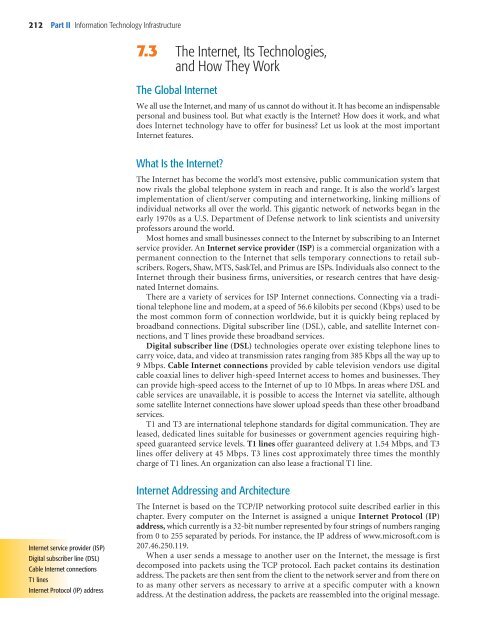Telecommunications, the Internet, and Wireless ... - Pearson Canada
Telecommunications, the Internet, and Wireless ... - Pearson Canada
Telecommunications, the Internet, and Wireless ... - Pearson Canada
Create successful ePaper yourself
Turn your PDF publications into a flip-book with our unique Google optimized e-Paper software.
212 Part II Information Technology Infrastructure<br />
7.3 The <strong>Internet</strong>, Its Technologies,<br />
<strong>and</strong> How They Work<br />
The Global <strong>Internet</strong><br />
We all use <strong>the</strong> <strong>Internet</strong>, <strong>and</strong> many of us cannot do without it. It has become an indispensable<br />
personal <strong>and</strong> business tool. But what exactly is <strong>the</strong> <strong>Internet</strong>? How does it work, <strong>and</strong> what<br />
does <strong>Internet</strong> technology have to offer for business? Let us look at <strong>the</strong> most important<br />
<strong>Internet</strong> features.<br />
What Is <strong>the</strong> <strong>Internet</strong>?<br />
The <strong>Internet</strong> has become <strong>the</strong> world’s most extensive, public communication system that<br />
now rivals <strong>the</strong> global telephone system in reach <strong>and</strong> range. It is also <strong>the</strong> world’s largest<br />
implementation of client/ server computing <strong>and</strong> internetworking, linking millions of<br />
individual networks all over <strong>the</strong> world. This gigantic network of networks began in <strong>the</strong><br />
early 1970s as a U.S. Department of Defense network to link scientists <strong>and</strong> university<br />
professors around <strong>the</strong> world.<br />
Most homes <strong>and</strong> small businesses connect to <strong>the</strong> <strong>Internet</strong> by subscribing to an <strong>Internet</strong><br />
service provider. An <strong>Internet</strong> service provider (ISP) is a commercial organization with a<br />
permanent connection to <strong>the</strong> <strong>Internet</strong> that sells temporary connections to retail subscribers.<br />
Rogers, Shaw, MTS, SaskTel, <strong>and</strong> Primus are ISPs. Individuals also connect to <strong>the</strong><br />
<strong>Internet</strong> through <strong>the</strong>ir business firms, universities, or research centres that have designated<br />
<strong>Internet</strong> domains.<br />
There are a variety of services for ISP <strong>Internet</strong> connections. Connecting via a traditional<br />
telephone line <strong>and</strong> modem, at a speed of 56.6 kilobits per second (Kbps) used to be<br />
<strong>the</strong> most common form of connection worldwide, but it is quickly being replaced by<br />
broadb<strong>and</strong> connections. Digital subscriber line (DSL), cable, <strong>and</strong> satellite <strong>Internet</strong> connections,<br />
<strong>and</strong> T lines provide <strong>the</strong>se broadb<strong>and</strong> services.<br />
Digital subscriber line (DSL) technologies operate over existing telephone lines to<br />
carry voice, data, <strong>and</strong> video at transmission rates ranging from 385 Kbps all <strong>the</strong> way up to<br />
9 Mbps. Cable <strong>Internet</strong> connections provided by cable television vendors use digital<br />
cable coaxial lines to deliver high-speed <strong>Internet</strong> access to homes <strong>and</strong> businesses. They<br />
can provide high-speed access to <strong>the</strong> <strong>Internet</strong> of up to 10 Mbps. In areas where DSL <strong>and</strong><br />
cable services are unavailable, it is possible to access <strong>the</strong> <strong>Internet</strong> via satellite, although<br />
some satellite <strong>Internet</strong> connections have slower upload speeds than <strong>the</strong>se o<strong>the</strong>r broadb<strong>and</strong><br />
services.<br />
T1 <strong>and</strong> T3 are international telephone st<strong>and</strong>ards for digital communication. They are<br />
leased, dedicated lines suitable for businesses or government agencies requiring highspeed<br />
guaranteed service levels. T1 lines offer guaranteed delivery at 1.54 Mbps, <strong>and</strong> T3<br />
lines offer delivery at 45 Mbps. T3 lines cost approximately three times <strong>the</strong> monthly<br />
charge of T1 lines. An organization can also lease a fractional T1 line.<br />
<strong>Internet</strong> service provider (ISP)<br />
Digital subscriber line (DSL)<br />
Cable <strong>Internet</strong> connections<br />
T1 lines<br />
<strong>Internet</strong> Protocol (IP) address<br />
<strong>Internet</strong> Addressing <strong>and</strong> Architecture<br />
The <strong>Internet</strong> is based on <strong>the</strong> TCP/ IP networking protocol suite described earlier in this<br />
chapter. Every computer on <strong>the</strong> <strong>Internet</strong> is assigned a unique <strong>Internet</strong> Protocol (IP)<br />
address, which currently is a 32-bit number represented by four strings of numbers ranging<br />
from 0 to 255 separated by periods. For instance, <strong>the</strong> IP address of www.microsoft. com is<br />
207.46.250.119.<br />
When a user sends a message to ano<strong>the</strong>r user on <strong>the</strong> <strong>Internet</strong>, <strong>the</strong> message is first<br />
decomposed into packets using <strong>the</strong> TCP protocol. Each packet contains its destination<br />
address. The packets are <strong>the</strong>n sent from <strong>the</strong> client to <strong>the</strong> network server <strong>and</strong> from <strong>the</strong>re on<br />
to as many o<strong>the</strong>r servers as necessary to arrive at a specific computer with a known<br />
address. At <strong>the</strong> destination address, <strong>the</strong> packets are reassembled into <strong>the</strong> original message.
















